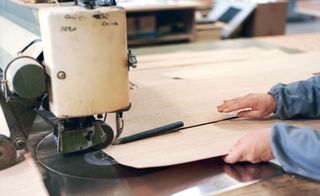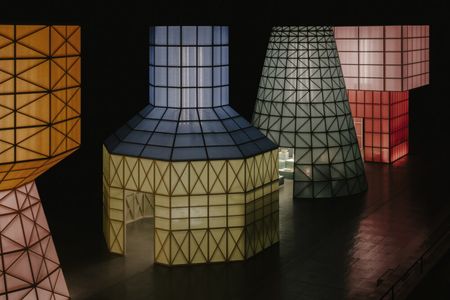Inner sanctum: the making of the tabernacle, by Giacomo Moor and Emmemoboli

We liked the idea of creating a new take on the tabernacle, the ornate cabinet in which the Eucharist is stored in Christian churches. Most are wrought in baroque gold and Gothic curves, so we called on Giacomo Moor to help us find a new aesthetic for the sacred container. ‘The request was unexpected, and rather surprising,’ says the Italian designer. ‘As an atheist, I was curious about the invitation to rethink an object so strictly linked to religion.’
Moor did his homework, noting that, throughout history, the tabernacle has taken different forms and offered different experiences, from the architectural and immersive to a box-like urn. Moor also got etymological. ‘Tabernacle comes from the Latin word taberna, meaning abode,’ he explains. In fact, he points out, in both Jewish and Christian religions, the tabernacle is a kind of mobile home for the divine. ‘To me, this meaning evokes an interaction with the object, a private, intimate space to explore one’s own spirituality.’
Based in Milan, Moor runs one of Italy’s youngest carpenters’ workshops, and is a rare example of an Italian creative who designs, builds and installs his own furniture. Since launching GM Studio in 2011, he has worked on private commissions and collaborated with local galleries such as Memphis’ Post Design and ProjectB. His interiors feature minimalist, made-to-measure compositions in wood; sleek and dynamic, they highlight the lightness of the material.
Moor created the tabernacle in collaboration with Brianza-based furniture brand Emmemobili. The company was founded in the 1980s by the Tagliabue family, which had been producing wooden furniture since 1879. Emmemobili is now known for its impressive collection that combines traditional woodworking techniques with innovative forms, and has collaborated with designers such as Ferruccio Laviani and Matteo Thun. ‘We knew Giacomo and his work, but we never had the chance of collaborating with him until now,’ says Maurizio Rainoldi, the company’s commercial director who, with owner Giuseppe Tagliabue, followed the project through every step of the process. ‘Wallpaper* gave us the opportunity to turn this interest into a concrete collaboration.’
Moor and Rainoldi initially met to discuss the intrinsic meaning of the tabernacle, and their intentions for the piece. ‘We discovered we were really in sync during our first exchanges of ideas,’ says Rainoldi. ‘We agreed the tabernacle should be a symbolic totem, beyond a specific faith. A place to give energy to an individual, whatever his religious beliefs.’

A raffia box provides an element of contrast and ‘the actual tabernacle’, says Moor/em>
At first glance, Moor’s design looks like an unassuming, beautifully crafted, Canaletto walnut cabinet. Its monolithic appearance is broken down by subtle, asymmetrical panelling, arranged around a central element made of raffia. ‘The actual tabernacle is this central piece,’ explains Moor, who wanted to create a juxtaposition between the humble straw box and the rich wood around it.
‘When closed, the entire piece is a totemic cupboard, but once its two L-shaped doors are opened, they reveal an intimate world, featuring boxes, shelves and drawers,’ explains Rainoldi. Inside, the doors are lacquered in blue, creating a contrast. Moor sees the design as functional micro-architecture, an intimate place that could be used as a workspace, a writing desk, a display cupboard or domestic storage.
The piece was made entirely by Emmemobili’s specialist team in Cantù, near Lake Como, using a combination of hand work and specialist machinery. ‘Our work is more similar to haute couture than to prêt-à-porter,’ notes Rainoldi. ‘In this case, we drew from the company’s DNA to develop the different elements that form the piece.’ He also notes that although the company’s collection features highly expressive pieces, achieved with complex constructions, the tabernacle was different, appearing unassuming when closed and saving the emotional punch for when it opens.

The tabernacle, clad in rich Canaletto walnut veneer.
‘My intention was to translate the concept of a tabernacle into a universal idea, adding functionality and some small surprises, which are unveiled as you use it,’ adds the designer. Compared with his independent projects, the Handmade assignment with Emmemobili offered him the chance to develop a unique collaborative relationship. ‘This kind of collaboration is very different from my solo projects, or those I develop with galleries,’ explains Moor. ‘Here, I learned a lot about the company’s specific know-how, because there is a bigger exchange of opinions. I think a finished product should always be the result of a synergy between the company and the designer.’
For Emmemobili, this is a guiding principle; the brand has established solid relationships with some of Italy’s leading designers, producing an eclectic portfolio of furniture. Its back-catalogue includes pieces such as Ferruccio Laviani’s ‘Twaya’ table, a sculptural wooden marvel that mimics the waves of a table cloth, as well as his asymmetric boiserie, which plays with traditional interiors archetypes in a radical fashion.
‘We like challenges,’ says Rainoldi. ‘And although the tabernacle might not look like it posed many difficulties, our team had to find the best solution to problems such as how to create the central straw element.’
Rainoldi and Moor agree that their favourite moment of the collaboration was seeing the finished piece, four months after being asked to imagine and create a tabernacle for Wallpaper’s Holy Handmade! exhibition in Milan this spring. ‘When I am not producing a piece that I have designed, I always marvel at seeing the finished product,’ says Moor. ‘I imagine it, I think about it, but when I see it in the flesh, the impact is always stronger.’
As originally featured in the August 2017 issue of Wallpaper* (W*221)

Left, company owner Guiseppe Tagliabue. Right, Milanese carpenter and designer Giacomo Moor

Cutting and installing the Canaletto walnut veneer

Cutting and installing the Canaletto walnut veneer
INFORMATION
For more information, visit the Giacomo Moor website and the Emmemobili website
Wallpaper* Newsletter
Receive our daily digest of inspiration, escapism and design stories from around the world direct to your inbox.
Rosa Bertoli was born in Udine, Italy, and now lives in London. Since 2014, she has been the Design Editor of Wallpaper*, where she oversees design content for the print and online editions, as well as special editorial projects. Through her role at Wallpaper*, she has written extensively about all areas of design. Rosa has been speaker and moderator for various design talks and conferences including London Craft Week, Maison & Objet, The Italian Cultural Institute (London), Clippings, Zaha Hadid Design, Kartell and Frieze Art Fair. Rosa has been on judging panels for the Chart Architecture Award, the Dutch Design Awards and the DesignGuild Marks. She has written for numerous English and Italian language publications, and worked as a content and communication consultant for fashion and design brands.
-
 Fluid workspaces: is the era of prescriptive office design over?
Fluid workspaces: is the era of prescriptive office design over?We discuss evolving workspaces and track the shape-shifting interiors of the 21st century. If options are what we’re after in office design, it looks like we’ve got them
By Ellie Stathaki Published
-
 This collection of slow furniture is a powerful ode to time
This collection of slow furniture is a powerful ode to timeA serene exhibition of David Dolcini's 'Time-made' collection has fast-tracked its place into our hearts and homes
By Ifeoluwa Adedeji Published
-
 Is the Pragma P1 the most sustainable watch yet?
Is the Pragma P1 the most sustainable watch yet?Geneva-based brand Pragma combines industrial design with real sustainable credentials
By Hannah Silver Published
-
 ‘You don't want space; you want to fill it’: Milan exhibition
‘You don't want space; you want to fill it’: Milan exhibitionMaking its debut during Milan Design Week 2022 at Marsèll Paradise, a new exhibition by Matylda Krzykowski, explores how we approach the space we live in (until 15 July 2022)
By Cristina Kiran Piotti Last updated
-
 Kohler and Daniel Arsham brought experiential art to Milan Design Week
Kohler and Daniel Arsham brought experiential art to Milan Design WeekLooking back on Daniel Arsham and Kohler’s Divided Layers installation, and the brand’s latest bathroom collection
By Simon Mills Last updated
-
 Men’s mental health takes centre stage at an art and design exhibition by Tableau
Men’s mental health takes centre stage at an art and design exhibition by Tableau‘Confessions’, which travels to Copenhagen’s 3 Days of Design following its debut at Milan Design Week 2022, features commissioned work by 14 male artists, designers and architects, reflecting on toxic masculinity, vulnerability and mental health
By TF Chan Last updated
-
 Recycled glass tiles by Studio Plastique, Snøhetta and Fornace Brioni launch in Milan
Recycled glass tiles by Studio Plastique, Snøhetta and Fornace Brioni launch in MilanThe ‘Forite’ tile collection, which upcycles glass components from discarded fridges, ovens and microwaves, launches with an exhibition at Alcova during Milan Design Week 2022
By TF Chan Last updated
-
 Hermès’ annual Milan Design Week spectacle is inspired by brutalist water towers
Hermès’ annual Milan Design Week spectacle is inspired by brutalist water towersBringing colour and lightness to Fuorisalone 2022, Hermès’ installation at La Pelota conceals the maison’s latest collections of furniture, accessories and lighting
By Rosa Bertoli Last updated
-
 Alcova: wellbeing, cultural identity and the environment in focus at Milan Design Week 2022
Alcova: wellbeing, cultural identity and the environment in focus at Milan Design Week 2022In its fourth edition during Milan Design Week 2022, Alcova brings together a diverse group of designers and brands curated by Valentina Ciuffi and Joseph Grima
By Sujata Burman Last updated
-
 New Giorgetti furniture balances beauty and functionality
New Giorgetti furniture balances beauty and functionalityNew Giorgetti furniture, revealed at Salone del Mobile 2022 and photographed here at the rationalist Castrocaro Terme, is perfectly poised between beauty and functionality
By Rosa Bertoli Last updated
-
 Philippe Starck reinterprets Dior’s Louis XVI Medallion chair in Milan
Philippe Starck reinterprets Dior’s Louis XVI Medallion chair in MilanDior has commissioned Philippe Starck to put a contemporary twist on a classic piece of seating for Milan Design Week 2022, complete with an immersive installation at Palazzo Citterio
By TF Chan Last updated